. Introduction
Archaeological site Sowinki no. 23A is located in Greater Poland province (województwo wielkopolskie), about 35 km south-east of Poznań. It is situated on a vast, sandy headland at the edge of the Warta river valley fluvial terrace. The entire site was excavated in the years 1989–1991, in connection with a planned construction of a water treatment plant for the city of Poznań. Sowinki site no. 23A is a multicultural site (Krzyszowski, 1992, 1995, 1997, 2014), with the remains of occupation ranging chronologically from the Mesolithic to the Medieval period (Fig. 1). The examined area provides a record of the history of Greater Poland (Poznań) region tracing back to about seven and a half thousand years ago.
Figure 1
Chart demonstrating the chronological scope of archaeological cultures identified in Sowinki.
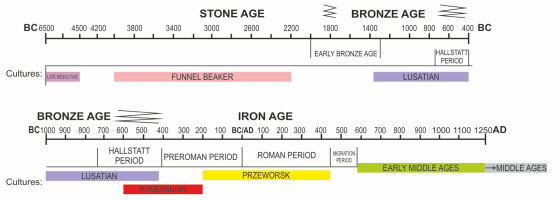
The above necropolis is the most important discovery at the site of Sowinki due to the scope of excavations allowing for the exploration of its entire area, a long period of use, dating — which is worth emphasizing — to the beginnings of the Poland’s state, as well as the scarcity of other skeletal cemeteries from the time of the early Piasts’ dynasty. Also, findings concerning the site provide a valuable background for the study on the emergence of the early medieval culture of elites. Notably, some of the artefacts unearthed at Sowinki have analogies with Scandinavian finds of the Middle and Late Viking periods.
. Archaeological background
Sowinki site no. 23A is a multicultural site. The excavations covered an area of about 1.5 ha and revealed altogether 580 features representing 7 chronological-cultural horizons, which include:
a campsite dating to the Late Mesolithic period (about 6–5 thousand years BC) — the remains of the “younger” settlement involved over a dozen flint items, including microlithic cores, truncated blades, scrapers, as well as blades and flakes (Fig. 2);
Figure 2
Artefacts from the oldest cultural horizons in Sowinki; a) Mesolithic flint artefacts; from the left: cores, scrapers, truncated blades and retouched flakes (on the right); b) profile of a cloche type cremation grave (no. 174) of the Pomeranian culture; c) grave no. 59 of the Pomeranian culture; d) reconstructed vessels-cinerary urns from a cist grave no. 59.
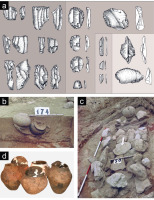
a settlement site attributed to the communities of the Funnel Beaker culture dating to the Neolithic period (so called Wiórecka phase, about 3.5–3 thousand years BC) — distinguished on the basis of several dozen pottery fragments of, among others, the Funnel Beaker culture. No features were recorded at this site; however, they had probably been destroyed by more numerous “younger” remains of the communities of the Lusatian culture, Pomeranian culture and early medieval occupation;
a settlement attributed to the communities of the Lusatian culture dating to the Hallstatt period HaCD (about 700–450 BC) — the finds included 383 features and several hundred pottery fragments, testifying the existence of a vast settlement with several dwellings, outbuildings and production facilities; nearly all the boundaries of this settlement were registered during the research, except for its north-eastern periphery;
a cremation cemetery attributed to the communities of the Pomeranian culture dating to the Roman Influence period (about 400–300 BC) — the research revealed 43 burials of this cultural unit (heavily destroyed) comprising altogether the remains of 55 people. They were deposited in a central part of the site located on an elevation. The most outstanding of various grave types recorded at this cemetery were two cist graves; one of them, intact, comprised stone constructions containing 13 cinerary urns with human remains; possibly this was a family burial (Fig. 2);
a settlement site attributed to the Przeworsk culture dating to the Pre-Roman period LtC (about 200–100 BC) — registered finds comprised two features (pits) and several pottery fragments, which belonged to the south-western periphery of a settlement of the same cultural unit, situated at a neighbouring site of Sowinki 23B;
a skeletal cemetery dating to the Early Medieval period (from the second half of the 10th cent. to the first half of the 12th cent.) — unearthed features involved 150 graves containing altogether 158 burials (Figs. 3, 4, 5), 82 of which comprised 250 so called selected artefacts. The most numerous among these finds were everyday utensils (134 items): knives with leather sheaths, whetstones, firesteels, scissors, awls, pottery vessels, stave buckets, fishing spears, fishing hooks, as well as objects of special character, such as balance scales, weights, metal fittings and nails, coins (Figs. 4, 5). Other artefacts deposited in graves included dress elements and ornaments (90 items): temple rings, glass and amber beads, semi-precious stone beads, rings, pendants, belt buckles. Finally, the examined burials contained elements of military equipment (altogether 6 items): spear heads, arrow heads, battle axes, spurs and spur straps.
Figure 3
Plan view of skeletal cemetery from the Early Medieval period, with division into phases and radiocarbon dates for 8 burials; 1 — the graves containing radiocarbon dated samples; 2 — ditches surrounding graves; 3 — northern boundary of the excavation; 4 — probable boundary of chronological phases of the cemetery.
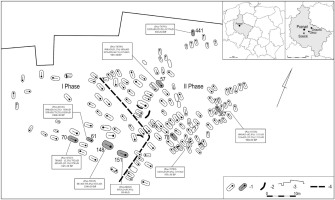
Figure 4
Early Medieval period; a) furnishings of chamber grave no.148: 1–2: knives in lather sheaths; 3: fittings of knives’ sheath; 4: ring; b) plan view of a chamber grave no.148, with the remains of iron; c) silver ring from a chamber grave no.148; d) iron knives in leather sheaths, with bronze decorative fittings from different graves, from the top to the bottom: grave no. 164, grave no. 151, grave no. 148 and grave no. 176.
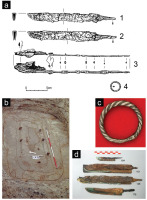
Figure 5
Early Medieval findings in Sowinki; a) bronze balance scales from a merchant’s grave no. 70; b) a set of weights from a merchant’s grave no. 70, A — lead weights, B — probable stone weight uses for tarring, C — iron weights coated with bronze; c) reconstructed stave bucket from a chamber grave no. 151; d) silver coin (minted in Saxony in the years 1020–1040) from grave no. 164; e) beads made of semiprecious Stones (carnelian or rock crystal) from the grave no. 30.
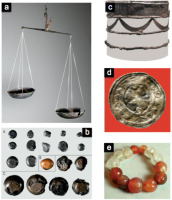
a settlement trace dating to the Late Medieval period (14th–15th cent.AD) — a single feature (pit) containing an iron artefact and several wheel-thrown pottery fragments;
Detailed analyses and 14C measurement were provided for samples from the skeletal cemetery dating to the Early Medieval period (Fig. 3). The analysis of grave furnishings has indicated social differentiation within the community. Four graves, outstanding in terms of equipment, have been identified as burials of a privileged group (chamber graves no. 148 and 151; and graves no. 61 and 70), (Figs. 4, 5).
Previously, chronological frameworks of the Sowinki site were determined on the basis of relative chronology, according to stratigraphy of sediments, examination of metal finds, pottery and flint objects. These studies revealed that the cemetery at Sowinki had been used in the period between the second half of the 10th cent. and the first half of the 12th cent. The above archaeological findings have been verified through radiocarbon dating of the material collected from several graves (Fig. 3). The archaeological site at Sowinki is compatible in terms of chronology and the equipment of the most important graves with other early medieval cemeteries located in the area of Poland (Błaszczyk and Stępniewska, 2016; Buko and Kara, 2014; Bojarski et al., 2010, 2016; Buko et al., 2013; Grygiel, 2014; Janowski, 2011a, 2011b; Ratajczyk, 2013; Sikora, 2013, 2015; Wrzesiński, 2010; Wrzesińska and Wrzesiński, 2016).
. Materials and methods
Samples of wood and bones representing various periods were collected from different features, including mostly cellar pits, refuse pits and grave pits. The deposition depth of the analysed samples did not exceed 100 cm below ground level. Radiocarbon dating was carried out so far on 8 samples, all of which were acquired from grave pits of the skeletal cemetery dating to the Early Medieval period (Figs. 4, 5, Table 1).
Table 1
Samples from Sowinki, location and features characteristics.
Dating of wood fragment and bones was carried out in Poznan Radiocarbon Laboratory. Charcoal samples were prepared by the AAA method (Acid – Alkali – Acid) to remove any impurities, first carbonate (treated with a hydrochloric acid solution), than the organic pollutants, humic acids (treated with a solution of sodium hydroxide) and at the end to remove an atmospheric carbon (CO2), which could be absorbed by the samples during preparation (treated with hydrochloric acid again). Each time, the samples were bathed in deionised water to restore the neutral pH. Next step after the initial preparation involves combustion of the samples, processing of the CO2 to obtain a graphite and compression in a special holder to form a disc ready for AMS measurement.
In case of bones, collagen extraction procedure was applied (Longin, 1971; Stafford et al., 1987) with further modifications of basic treatment (Arslanov and Svezhentsev, 1993; Piotrowska and Goslar, 2002). Before extraction protocol, degree of collagen degradation is checked by measuring content of nitrogen and carbon in analysed bone (Table 2). The interval of acceptance for C/N atomic ratio is between 2.9 and 3.5 (van Klinken, 1999). Samples with higher ratios may have been contaminated with exogenous carbon and bones with lower ratios were prone to degradation. After analysis of the percent carbon content and C:N atomic ratio in bones, routine bone pretreatment procedure in the Poznań Radiocarbon Laboratory was applied (Brock et al, 2010; Brown et al., 1988, Poznan Radiocarbon Laboratory, 2016; Ambrose, 1990).
Table 2
Results of 14C dating; M — material, W — wood, N, C — nitrogen and carbon percentage, given for bone samples; Lab code: Poz — sample dated with the AMS technique in the Poznan Radiocarbon Laboratory; calibration with OxCal v4.2.4 (Bronk Ramsey et al., 2013) and IntCal13 atmospheric curve (Reimer et al., 2013).
. Results and discussion
Bone, wood and charcoal samples provided eight dates, which confirmed previous findings concerning different cultures registered in the studied area, and, additionally, they have helped to clarify the chronology of the early medieval cemetery. The demonstrated results are the first isotopic measurements taken for the site of Sowinki. The obtained data have allowed for defining two chronological phases of the early medieval cemetery (Fig. 6). The older one (phase I) covered the central-western part of the necropolis, and it dates to the period between 10/11th century and a half of the 11th century. This zone consisted only of graves arranged in several roughly parallel plots, without characteristic strictly organized rows, which, in turn, dominated in chronologically “younger” (phase II) south-eastern part of the cemetery dating to the period between the second half of the 11th cent. AD and the first half of the 12th cent. AD. The boundaries of phases were determined on the basis of relative chronology of artefacts, radiocarbon measurements and the dating of coins (Krzyszowski, 1995, 1997; Krzyszowski and Suchodolski, in press) in correlation with the layout and equipment of graves (Fig. 6).
Radiocarbon dating results of samples from Sowinki, together with probability for 68 and 95% are presented in Table 1. The distribution of the probability density function of the calendar age for selected samples were obtained using the OxCal v4.2.4 (Bronk Ramsey, 2013) and IntCal13 atmospheric curve (Reimer et al., 2013). The distributions are presented in Fig. 6, and also in numerical form in Table 2.
Figure 6
Calibration in graphical form; the boundaries of phases were determined on the basis of relative chronology, radiocarbon measurements and the dating of coins (Krzyszowski, 1995, 1997; Krzyszowski and Suchodolski, in press).
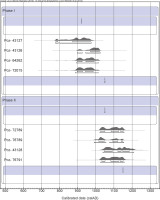
Radiocarbon dating results and some of the finds unearthed at Sowinki reveal the direction of cultural links between the early medieval Greater Poland and other regions. They include a merchant balance scales with a set of weights (from grave no. 70), identified as an import from the western European-Scandinavian cultural circle (Fig. 5). Its attribution derives not only from typological correlations, which point towards western European circle, but also from the study of spatial distribution of similar items in the provinces closest to Greater Poland and in the Elbe region. According to the analysis, the merchant’s equipment from Sowinki comprising balance scales and weights (with silver deposits), which can be dated to the period between the second half of the 10th cent. and the first half of the 11th cent., was not an uncommon type of find in the area of important trade routes. Such items dating to the corresponding period were found also in Gniezno, Giecz and Poznań, which clearly demonstrate their concentration in Greater Poland, the region that played a key political role in the early Polish state. The area in question was intersected by a network of trade roads, both local (functioning within the province), and far-reaching ones (linking western European states with eastern Europe and Bohemia). Crossing these routes merchants (and probably also craftsmen) met mostly in early urban centres, and, while on the way, they traded their goods also in the hinterland. Sowinki was probably such a stage post and possibly a crossing point on an early trade map leading from Poznań to the south along the Warta River. Other finds from Sowinki identified as probable imports include knives made according to the Viking technology, i.e. through welding a wrought iron core with steel plates on either side (so called “sandwich”), which has been revealed through metallographic analysis (Fig. 4).
Comparing the cemetery at Sowinki with other early medieval burial grounds containing elite chamber graves with “Rus-Scandinavian” elements in equipment one can clearly identify chronological correlation between them (Fig. 7). This comparison shows that the oldest chamber graves from Sowinki (no. 148 and 151) date from the same time horizon as their counterparts from the cemeteries at Pień (Drozd et al., 2009; Janowski, 2013, 2015), Bodzia (Buko and Kara, 2014; Buko et al., 2013; Kara, 2013; Müller-Wille 2015) and Ciepłe (Ratajczyk, 2013) — in the Kuyavian-Pomeranian land; Kałdus in Chełmno land (Bojarski et al., 2010, 2016); Lutomiersk in Łódź province (Grygiel, 2014), and Dziekanowice in Greater Poland (Wrzesiński, 2010; Wrzesińska and Wrzesiński, 2016).
Figure 7
Comparison of radiocarbon dates obtained for selected graves form older phases of early medieval cemeteries in the Polish lands (Sowinki site 23A, Pień site 9, Bodzia site 1, Dziekanowice site 22, Kałdus site 4, Lutomiersk site 1). Poz — laboratory number of samples dated by 14C in Poznań (Poland); Ki — Kiev (Ukraine); AA — Arizona (USA); MKL — Laboratorium Datowań Bezwzględnych at Cianowice near Kraków (Poland); (after references to each archaeological site, cited in the text).
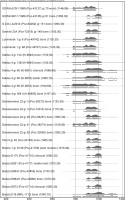
. Conclusion
On the basis of the historical material it has been determined that the cemetery in Sowinki was used from the second half of the 10th century up to the first half of the 12th century. The findings basing on the relative chronology have been verified through radiocarbon dating performed in Poznan Radiocarbon Laboratory for samples taken from eight graves, and through the dating of silver coins (Krzyszowski and Suchodolski, in press). The outcome data allowed for distinction of two chronological phases of the cemetery (Fig. 3). First, chronologically older phase (phase I), is situated in central-western part of the cemetery and dated to the period between 10th/11th century and the first half of the 11th century. The chronologically younger phase (phase II) is situated in the south-eastern part and is dated to the period from the second half of the 11th century up to the first half of the 12th century. In the older area (phase I) only graves formed into a few much about parallel strings have been noted, with no characteristic row layout, which dominates the “younger” phase (phase II).
An important matter was to obtain 14C dates especially from two graves: number 148 and 151 (from phase I), (Krzyszowski and Błaszczyk, 2016). They are the scarce examples of early medieval chamber graves on Polish lands, where the buried ones were probably young men equipped with rich grave accessories. Indubitably they belong to the one of the oldest, perhaps even founding burials at the cemetery at Sowinki. Both graves were created in the times of the so called first Piasts’ Monarchy, most probably during the reign of Bolesław Chrobry or even Mieszko I, which were the times of the intensive Christianisation, forming of grand social differentiation and development of the early-state structures in the Polish lands. The dates received from the radiocarbon measurements confirmed the previous findings in that scope, based upon traditional analysis of the archaeological materials, including coins (Krzyszowski, 1992, 1995, 1997, 2014; Krzyszowski i Suchodolski, in press). The cemetery at Sowinki with well-documented oldest chamber burials is compatible with (and yet probably the oldest of) other early-medieval cemeteries. Elite chamber graves with Rus-Scandinavian elements in their equipment have been documented also in: Kałdus on the Chełmno lands, Pień, Bodzia and Ciepło on the Kuyavian-Pomeranian lands as well as in Dziekanowice in Greater Poland. The above mentioned burials from Sowinki refer to a greater idea of so called chamber graves recorded in early medieval burial rites in Central and Eastern Europe and in Scandinavia, mostly in Sweden and Denmark (Janowski, 2015). Such graves were reserved for the members of contemporary elites, including people involved in trans-regional trade. The cemetery at Sowinki is one of the burial grounds, which possibly served as a resting place for representatives of the people of Scandinavian origin who settled in the Piasts’ state with the consent of the local authority.
